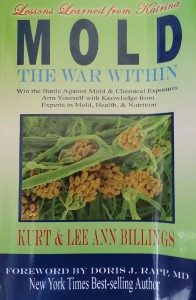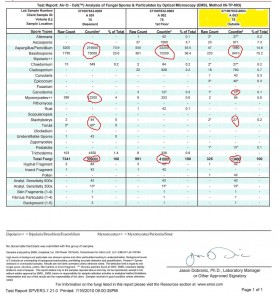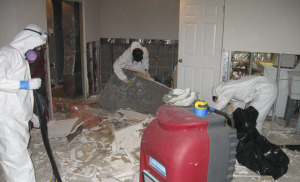[vc_row][vc_column][vc_column_text]
Molds are everywhere!
They are in the foods you eat, the beverages you enjoy, even the air you breathe.
Don’t believe me?
Think about that bread you ate in yesterday’s sandwich, or the cheese you might be eating right now. Without a certain kind of mold, you wouldn’t be able to enjoy either one.
Now think about that glass of wine or that beer you may be drinking right now as you’re reading this blog post. Both are made with a kind of mold.
Even that coffee and black tea you drink every morning wouldn’t be yours to enjoy without a certain species of mold that ferments them into the dark drinks you enjoy.
There are even molds in your body right now, in your digestive tract, helping you to break down the food and drink you enjoy so your body can absorb them.
Molds are the way that Mother Nature digests and decomposes organic tissue to make the compost we use in our gardens.
The fact is that for millennia, human beings have been in an active relationship with mold in the environment, in both health and illness.
So now you might be asking, “if molds are a part of our natural environment, what’s all this panic about exposure to mold?“
[/vc_column_text][/vc_column][/vc_row][vc_row][vc_column width=”1/3″][vc_column_text]

[/vc_column_text][/vc_column][vc_column width=”2/3″][vc_column_text]Recently we came across two books telling the tale of suffering and sickness due to exposure to environmental mold. Both books chronicle the harrowing experiences and debilitating illnesses caused by exposure to mold. . . and the authors’ eventual return to health.
The first book by Kathryn Chastain Treat (2013) “Allergic to Life: My Battle for Survival, Courage, and Hope” tells the story of how an active, intelligent woman became an invalid after exposure to mold in her workplace.
What started out as mere headaches soon evolved into an infection in her sinuses and bones. It was so bad it required intravenous antibiotics, 4 surgeries, and years of treatment to correct. Ultimately, Ms. Treat was diagnosed with cancer of the uterus – and the pathology reports confirmed that her cancer was caused by the mold exposure.
[/vc_column_text][/vc_column][/vc_row][vc_row][vc_column][vc_column_text]
After many false starts, and many years spent searching for treatment professionals who understood her illness, she now enjoys a somewhat limited return to the active life she enjoyed before she was exposed to mold.
Ms. Treat hosted a blog at http://allergictolifemybattle.wordpress.com/ where she chronicled her story. She passed away suddenly from a stroke in December of 2014. However, her website is still “live” and still offers hope and resources for people who have experienced the devastating illness that can accompany exposure to mold.
[/vc_column_text][/vc_column][/vc_row][vc_row][vc_column width=”1/3″][vc_column_text]

[/vc_column_text][/vc_column][vc_column width=”2/3″][vc_column_text]The second book by Kurt and Lee Ann Billings (2013) “Mold: The War Within” chronicles a whole family’s descent into suffering and hell due to mold exposure after Hurricane Katrina.
All the members of the family received multiple mis-diagnoses ranging from allergies, to thyroid disease, to depression. It was only their dogged determination to find the root cause of their symptoms that led to their eventual recovery.
Their book is replete with resources, interviews, and hard-won information about how to find, and get treatment for the body after exposure to mold. But only once it has been accurately diagnosed!
[/vc_column_text][/vc_column][/vc_row][vc_row][vc_column][vc_column_text]
There are two consistent elements in these unrelated tales:
1. First, the lack of, or improper environmental testing resulting in an inaccurate assessment of the level of dangerous exposure.
2. And second, a lack of, or improper medical testing leading to misdiagnosis and poor treatment.
And combined, these two elements occur because the risks to physical health from exposure to environmental molds are poorly understood.
At this point, you’re probably asking, “But, why is illness caused by mold so poorly understood? Isn’t there research demonstrating the danger?”
The answer, as the Billings found out, is complicated by medical, political and economic concerns:
“At the time, we didn’t realize that two basic factions exist within the medical community: one that understands that fungal spores can enter the body and cause ill health effects and another one that refutes the possibility – even though many of the health effects of fungal inhalation are well documented in published, peer-reviewed scientific and medical journals.” p. 169
According to data collected by the group at http://www.moldtests.org
“It is estimated that over 10 million Americans are sick with Mold related illnesses and have no idea why they’re sick or what has made them sick.”
Included in that group of 10 million people susceptible to illness after being exposed to mold are the very young, the very old, and anyone who is immunocompromised. This includes people with cancer, AIDS, and anyone currently taking steroid medications.
The symptoms of illness caused by mold range from the simply annoying to life-threatening:
- Constant Headaches
- Nose Bleeds
- Feelings of Constant Fatigue
- Breathing Disorders and asthma
- Coughing up blood or black looking debris
- Nausea
- Diarrhea
- Vomiting
- Loss of Appetite
- Weight Loss
- Hair loss
- Skin Rashes
- Open Sores on the Skin
- Short and long term memory loss
- Neurological & Nervous Disorders
- Sexual Dysfunction
- Swollen Glands in the Neck Area and under the Armpit
- Ear Infections and Pain
- Chronic Sinus Infections
- Chronic Bronchitis
- Pain in the Joints and Muscles
Mold has even been linked to cancers of the breast, brain, and in Ms. Treat’s case, cancer of the uterus.
Do the symptoms on this list sound familiar?
You’re not alone! But the list does highlight one of the most difficult things about mold sickness: it looks like many other diseases!
So, what can you do?
The only way to determine if your symptoms are from mold infection is to get tested.
But you need to get the right test for both the indoor air quality of your home and workplace as well as medical testing for your body to determine if it’s an illness caused by mold.
First, let’s talk about the right type of environmental testing.
There are 4 types of environmental testing for molds in the home or workplace.
Each type of test has an advantage over no testing at all. However, only one will help you get the most accurate picture of your level of risk in your home or work place environment.
1. Culture Testing
Culture tests use petri dishes where mold particles from the home or workplace are grown into larger mold colonies in a lab.
This test is useful only if you want to identify the species of molds in the indoor environment. The problem with this test is that only mold particles that are still alive will grow.
Dead mold particles in the home or work environment can still cause allergies and health problems. In addition, because molds are everywhere, this test can do little to tell you what the concentration of the mold in the air of the home or workplace is.
This is the kind of test that was performed in Ms. Treat’s workplace. Because it was the wrong test, she spent many years in needless suffering!
2. Swab or Tape Testing
Swab testing or tape testing, sometimes called “surface testing” is just what it sounds like.
All you do is swipe a special swab that looks like a Q-Tip over an area to take samples from surfaces. Or, a piece of tape is applied to the hard surfaces of the home or workplace, like the top of a desk or a window sill.
Unfortunately, this type of mold testing is unreliable because the results can only confirm that there is a presence of mold. But is won’t tell you the type or the concentration of spores in the air.
Because mold is everywhere and the spores are always around us, this test will always reveal the presence of mold. With this test, it is impossible to determine indoor air quality, the concentration of mold spores, or the extent of the mold problem.
3. Bulk Testing
Bulk testing involves collecting pieces of material from the home, like carpet or upholstery. Then, the material is taken to a laboratory where mold particles on the material are examined under a microscope.
Because mold is everywhere, the lab will always find its presence. But, the report from “bulk testing” can’t tell you how bad the concentration of mold is in the indoor air of your home or work environment or if you really do have a problem.
4. Air Sample Testing for Mold
Air sampling tests for mold in the home or workplace is the most best and most reliable environmental mold test there is. An air sampling mold test is a two-step process. First, an indoor environmental specialist samples the concentration of mold spores in your home’s air. Then he compares it to samples taken from the outside air. All the samples are taken to a lab and examined under a microscope.
The reason air sample testing is your best option for indoor air quality evaluation?
First, air sample tests can tell you if you have a mold problem because they measure the concentration of spores inside compared to the level outside.
Second, this test is helpful even if you can’t find the source of the mold growth.
But perhaps the best reason for doing an air sample test is that you can take the results of your air sample test to your physician.
Armed with this data, an individualized treatment program for illness caused by mold can get started. Then, you’ll be on your way to healing fast.
So save yourself time, money, and confusion. Get the right indoor environmental mold test done first!
[/vc_column_text][/vc_column][/vc_row][vc_row][vc_column width=”1/2″][vc_column_text]
In our Greater Philadelphia and Southern New Jersey region we are lucky to have two of the best experts who do the right kind of testing – air sample testing – for your home or workplace.
Steve West of Settler’s Home Inspections 866-744-3991
Joe Vitale of A-1 Home Inspections 856-309-5001
[/vc_column_text][/vc_column][vc_column width=”1/2″][vc_column_text]

[/vc_column_text][/vc_column][/vc_row][vc_row][vc_column width=”1/2″][vc_column_text]

[/vc_column_text][/vc_column][vc_column width=”1/2″][vc_column_text]
So I have my environmental mold test results.
Now what?
Once you know what has been making you sick, it’s time to get the remediation done. When you get your air sample test reports back from the lab, call 877-750-7876. This is not something you want to attempt on your own! Safeguard your health and your family by hiring us to take care of the problem.
Because we follow the IICRC recommended protocols for mold abatement, our team of trained mold remediation specialists will remove the problem and return your home or workplace to a healthy environment. And, we won’t call it a day until the final air sampling test -called a clearance test- comes back demonstrating that the mold has actually been remediated.[/vc_column_text][/vc_column][/vc_row][vc_row][vc_column][vc_column_text]
Then, it’s time to get medical testing for mold illness.
Unlike the Billings family and Ms. Treat who spent years looking for treatment professionals before they could finally get well, we are truly lucky in our Greater Philadelphia area to have not one, but two of the top professionals in the country who specialize in medical testing and treatment of mold related illness. These two physicians have the expertise, understanding, and knowledge of mold related illness you need in order to get better.
So, once you’re armed with the results of the right kind of environmental mold test report, these treatment professionals can design a program that is specific to you and your family so you no longer have to suffer with illness caused by mold!
Dr. M. Kyu Chung at
Chung institute of Integrative Medicine 856-222-4766
110 Marter Ave, Suite 507, Moorestown, NJ, 08057
And
Dr. Alan Magaziner at
Magaziner Center for Wellness 856-424-8222
1907 Greentree Road
Cherry Hill, New Jersey 08003
[/vc_column_text][/vc_column][/vc_row][vc_row][vc_column][vc_column_text]And remember:
And remember: If you suspect you have a mold problem or illness caused by mold, and need to get testing, always get environmental testing done from a different company than the one that does the mold removal and remediation!
PuroClean Emergency Recovery services does mold inspections and remediation – not testing!… So there is no conflict of interest. That way you can be certain you get what you pay for – Expert Mold Remediation Services!
[/vc_column_text][/vc_column][/vc_row]

Pingback: You might have a mold problem if . . . | PuroClean Emergency Recovery Services
Pingback: When Things Go Terribly, Horribly Wrong
Pingback: Mold? Or No? - PuroClean Emergency Recovery Services